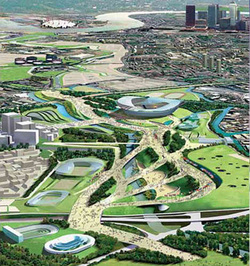I was automatically guilty of contributing to the emission of greenhouse gases into the atmosphere when I signed up for the Tiffin University Olympic Academic Experience. Through my travels, from my home in Northern California all the way to London Heathrow Airport, the jets that will take me from A to B will burn tremendous amounts of fuel that trap heat in our atmosphere. While I’m in London, I’ll consume plenty of food and drink. I’ll demand the infrastructure services of cars and trains to move me around town. I’ll require energy to light my dorm style room in the hostel. All my activities while abroad are unsustainable. But, what if my actions and activities can be mitigated? What if a sustainable strategy can be at the core of every activity of the London 2012 Olympic games?
Don’t worry about answering the above questions, the London Organizing Committee of the Olympic games already has. It is clear, that if our environment is degraded to the point where our athletic activities are no longer possible, we have nothing left. But the point of sustainability is to do things better, to create a future for our children to thrive in. After all, the word ‘ability’ is contained within sustainability.
The 2012 games organizers set out to plan, execute and leave the most sustainable games to date in their bid to host the games. However, there was no prolonged celebration upon winning the bid, terrorists bombed the London Underground the next day. The organizing committee and the many, many organizations, non government organizations (NGOs) and political entities set the sustainability strategy to focus on the developing the games to positively impact the neighborhoods of East London, a tough place with diverse populations, high crime and sub par housing, health and a failing education system. The five vital areas of climate change, waste, biodiversity, healthy living and inclusion are the foundations of the sustainability strategy in London, and were either pursued simultaneously or independently throughout the planning efforts.
It was the best of bids; it was the worst of bids. When the bid was won in 2005, the world’s economy was strong with good amounts of growth. Soon enough, the economy crashed in late 2008 and the organizers suddenly felt the strain of tighter budgets and public dissent. The area of East London had been neglected for quite some time and was especially hit hard when the worlds financial markets went south. By constructing the Olympic Park and related facilities in East London and the Lower Lea Valley, this community will enjoy the legacy of the 2012 games. Sustainable development of this area will increase East London’s livability and the improvements will be a benefit to London and Great Britain’s economy. The people in East London were integrated into plans through workforce training and unparalleled opportunity. Ten to fifteen percent of the Olympic Park construction workforce included citizens of this area. The London Employment and Skills Taskforce (LEST) was created to reduce unemployment in London and 10,000 plus unemployed people have been supported through job training and brokerage programs. An event of this magnitude should be a catalyst for change and serve to develop sustainable and prosperous communities. East London will benefit from the organizing committee’s commitment to inclusion for years to come.
The games may be held in London but the games are also for England. Heightened levels of excitement and nationalistic pride characterize the host nation. Organizers are taking this opportunity to develop local and deep impacting programs to increase participation in sports. It’s not just about celebrating world-class athletes exhibitions, the 2012 games overarching theme is “to inspire a generation.” To support the key sports business notion that participants are fans, these mega events need to focus on increasing long-term sporting opportunities for England’s, and the world’s youth. This generation is subject to the health problems caused by the modern diet, fast foods consisting of trans fats and high fructose corn syrup. Through its Legacy Action Plan, the Government has set the following targets: to be fourth in the Olympic medal table in 2012; to offer five hours of sport per week in the education system for all 5-16-year-olds by 2012 and three hours of sport per week for 16-19-year-olds by 2012; and to help at least two million people in England to be more active by 2012. It also aims to increase regular sports participation by one million by 2012-13. Of course, time will reveal how effective organizers were at using the Olympic games as a platform to inspire a generation to lead healthy and active lifestyles.
Organizers set out to support ecosystem services and biodiversity in the design of the Olympic park. East London and the Lower Lea Valley was an industrial wasteland, void of any wildlife. Choosing to develop this site will bode well for the future. Effectively planning to boost ecosystem services that support species and habitats, while minimizing construction impact, is at the core of the Olympic park development strategy. Riverbeds were widened to support habitats for wildlife. Water features contribute to high levels of biodiversity; it should be no surprise that 300,000 wetland specific plants were placed to support wildlife’s return to this area. I consider the highlight of this park to be the urban forest of over 2,000 trees. The value of an urban forest appreciates with the growth of the trees. Trees utilize carbon-based particles to feed and support plant tissue growth and then modify these particles into fresh and clean oxygen for us to breath. By using the Olympic Park to enhance habitat for wildlife, spectators visiting the grounds will learn valuable lessons about the importance of biodiversity and provide a beautiful natural backdrop to the action of the 2012 Olympic games.
The idea of reduce, reuse and recycle will be an essential practice for the world, and individuals, to pursue to create a better world for the next generation. Sport organizations and event shave a leadership role to exercise when it comes to promoting environmentally friendly practices. The Olympic Stadium demonstrates this obligation. Constructed with a tenth of the steel needed for Beijing’s ‘Birds Nest’ stadium, the stadium has a fixed capacity of around 25,000 and 50,000 in temporary seating. Unused gas pipelines were sourced to support the roof of the structure. The design of this particular stadium eliminates the ‘white elephant’ problem these types of events create. South Africa has encountered this problem as they cannot support the costs or find tenants to play in stadiums built for three week long sporting events. Rubble created from the demolition of existing buildings in the lower Lea Valley was re-used to fill bridges in the park. But when spectators and national teams start to arrive and visit the Olympic Park, the waste strategy needs to focus on waste minimization and recovery. The level of spectator consumption is positively correlated to the amount of waste generated. Organizers have set up systems to treat all waste as a potential resource and ensure that at least 70 per cent of Games-time waste will be reused, recycled or composted. And during the 77 day surrounding the Olympics, 0 percent of waste will be sent to landfills. Big, audacious goals are set for the entirety of the event and it seems organizers have an extremely high level of understanding of the task at hand. Look for future blog posts about how this waste strategy was communicated to spectators based on my experiences.
As alluded to in the beginning of this post, the emissions from my travels will harm the environment. And if you have read to this part of the entry,
this
ones for you. Regardless of what scientists say, there is no denying that human actions have altered every aspect of the natural environment. The situation we are in is best described in this
video. Going forward, we need to track the impacts our actions have on our planet to get a better understanding of where have made progress and where we need to improve. Bill Gates once said that ‘information is the reduction of uncertainty.’ The London 2012 Games will be the first Summer Games to map its complete carbon footprint over the entire project. This vast undertaking is underpinned by our four key aims concerning carbon management: to avoid and eliminate emissions at source; to reduce inefficiency in energy use, transport and work practices; to replace inefficient systems with low-carbon technology alternatives; and to compensate for unavoidable emissions by influencing behavioral change and standards so that others follow suit. The challenge from here on out is to drive behavior change and to find creative, innovative business solutions that will transform the human experience on this planet.
The Olympic games in London have pledged to be the most sustainable Olympic games and will deliver on that promise. From here on out, bidding cities will have to seriously consider the sustainability strategy they plan to execute and communicate it effectively into the bid they submit for the IOC. The greatest challenge sport organizations face in sustainability is encountered in the planning stage. The London organizing committee has done a great job in staging this worldwide mega event. Future teams and general society will benefit greatly from their ambitious plans. “If you can put sustainability at the heart of a project which is the largest logistical exercise in peace time ... then you can do it anywhere,” a quote from David Stubbs, London 2012 Head of Sustainability.
Information used to write this post was gathered from the following websites and text. There are some full excerpts from the sustainability plan summary contained within this entry.
http://www.london2012.com/mm/Document/Publications/Sustainability/01/24/08/07/london-2012-sustainability-plan-summary.pdf http://www.cnn.com/2012/07/10/world/europe/london-2012-olympics-environment/index.html Savery, Jill, and Keith Gilbert.
Sustainability and Sport. Champaign, IL: Common Ground, 2011. Print.


 RSS Feed
RSS Feed